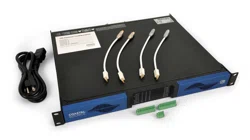Loading ...
Loading ...
Loading ...

4 : 6.Gain selection
The CRS amplifiers can operate with different gain
applied to the input signal. This feature is designed to match
the voltage of the input signal, i.e. allowing to obtain the same
output power at different input levels.
GAIN
Input sensitivity @ 8Ω load
Vpeak Vrms dBu
2800/4
26 6.92 4.9 16.0
29 4.90 3.47 13.0
32 3.46 2.45 10.0
35 2.45 1.74 7.0
1400/4
26 4.89 3.46 13.0
29 3.48 2.46 10.0
32 2.45 1.74 7.0
35 1.74 1.23 4.0
700/4
26 3.46 2.45 10.0
29 2.46 1.74 7.0
32 1.72 1.23 4.0
35 1.23 0.87 1.0
TAB. 2: Input sensitivity.
A proper combination of the position of two GAIN
switches on the rear panel sets the operating gain of the
amplifier (see TAB. 3)
26 dB 29 dB 32 dB 35 dB
1 2 3 4 5 6 7 8
1 2 3 4 5 6 7 8
1 2 3 4 5 6 7 8
1 2 3 4 5 6 7 8
TAB. 3: Setting the GAIN.
4 : 7.Lo-Z 2Ω load operation
The CRS amplifiers are optimized for working with 4Ω
output loads but a special configuration allows to connect
low loads down to 2Ω (e.g. in the configuration with three
paralleled 8Ω loudspeakers that provides 2.67Ω load to the
output channel).
The 2Ω switch (see Panel D, p. 5) allows to activate on
all output channels set to match low impedance (i.e. in Lo-Z
configuration) an operating condition that optimizes the
performance with very low loads, by limiting the maximum
output voltage to 85 V
peak
per channel.
For optimal 2Ω performance, it is recommended to
select LowZ mode for all the amplifier’s channels
4 : 8.Diagnostics - GPO - Alarms
The amplifier’s GPO – general purpose output – system
implements triggering signals to broadcast alarms.
CRS amplifiers provide a pair of paralleled general
purpose output connections per channel: one Normally
Open NO and one Normally Closed NC.
The connections are available on the back panel via the
12-pin Phoenix MC 1.5/12-ST-3.81 1803675 connector: see
Panel G, p. 6 for wirings.
These contacts are used to report potentially dangerous
faults or generally unsafe operation conditions by toggling
alarm switches relative to the following events, and any fault
preventing the normal operation of an output channel:
f No AC mains (i.e. system shutdown);
f Thermal stress: the system temperature is too high
and the thermal protection is engaged;
f Short circuit in output wiring: either the loudspeaker or
the line is in short;
f Amplifier is in Standby
CRS amplifiers features further monitoring on pilot tone
and output load: the monitoring and diagnostic interface
is accessible in Armonía Pro Audio Suite software through
the Diagnostic tab in the output ways panel of the selected
channel of the CRS amplifier.
4 : 8.1. Pilot tone monitoring
Thanks to the built-in DSP, the CRS amplifiers implement
pilot tone detection and alert. Detecting and alerting
features are available for both input and output pilot tones
on each channel.
The detection of a mismatch in the input pilot tone
parameters (frequency and voltage level) can be used to
trigger the backup policy and activate an alert through the
general purpose output switch.
The output pilot tone detection relies on an external
signal passing through the amplifier or the internal post DSP
pilot tone generator; in both cases any mismatch between
the detected signal and the set thresholds triggers the
general purpose output switches.
4 : 8.2 . Output load monitoring
Through the Armonía Pro Audio Suite software it is
possible to set the thresholds on the load impedance, at
given frequency, that trigger the general purpose output of
any channel in the CRS amplifiers.
Coastal Source recommends to use the built-in HPF (High
Pass Filter) when the amplifier is set to drive a distributed
line to prevent loudspeaker transformer saturation which
can considerably degrade sound performance. The HPF
can be activated by means of the DIP switch corresponding
to the channel (see Panel O, p. 7), two cutting frequency are
available 35 Hz and 70 Hz.
FIG. 2: Diagnostic panel in Armonía Pro Audio Suite.
CRS | 15
Loading ...
Loading ...
Loading ...
